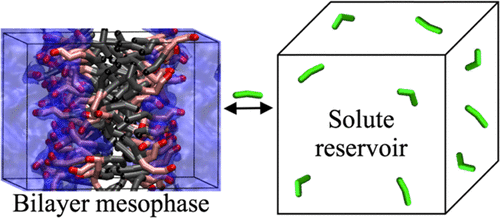Langmuir 34, 8245–8254 (2018)
Understanding solute uptake into soft microstructured materials, such as bilayers and worm-like and spherical micelles, is of interest in the pharmaceutical, agricultural, and personal care industries. To obtain molecular-level insight on the effects of solutes loading into a lamellar phase, we utilize the Shinoda–Devane–Klein (SDK) coarse-grained force field in conjunction with configurational-bias Monte Carlo simulations in the osmotic Gibbs ensemble. The lamellar phase is comprised of a bilayer formed by triethylene glycol mono-n-decyl ether (C10E3) surfactants surrounded by water with a 50:50 surfactant/water weight ratio. We study both the unary adsorption isotherm and the effects on bilayer structure and stability caused by n-nonane, 1-hexanol, and ethyl butyrate at several different reduced reservoir pressures. The nonpolar n-nonane molecules load near the center of the bilayer. In contrast, the polar 1-hexanol and ethyl butyrate molecules both load with their polar bead close to the surfactant head groups. Near the center of the bilayer, none of the solute molecules exhibits a significant orientational preference. Solute molecules adsorbed near the polar groups of the surfactant chains show a preference for orientations perpendicular to the interface, and this alignment with the long axis of the surfactant molecules is most pronounced for 1-hexanol. Loading of n-nonane leads to an increase of the bilayer thickness, but does not affect the surface area per surfactant. Loading of polar additives leads to both lateral and transverse swelling. The reduced Henry’s law constants of adsorption (expressed as a molar ratio of additive to surfactant per reduced pressure) are 0.23, 1.4, and 14 for n-nonane, 1-hexanol, and ethyl butyrate, respectively, and it appears that the SDK force field significantly overestimates the ethyl butyrate–surfactant interactions.
